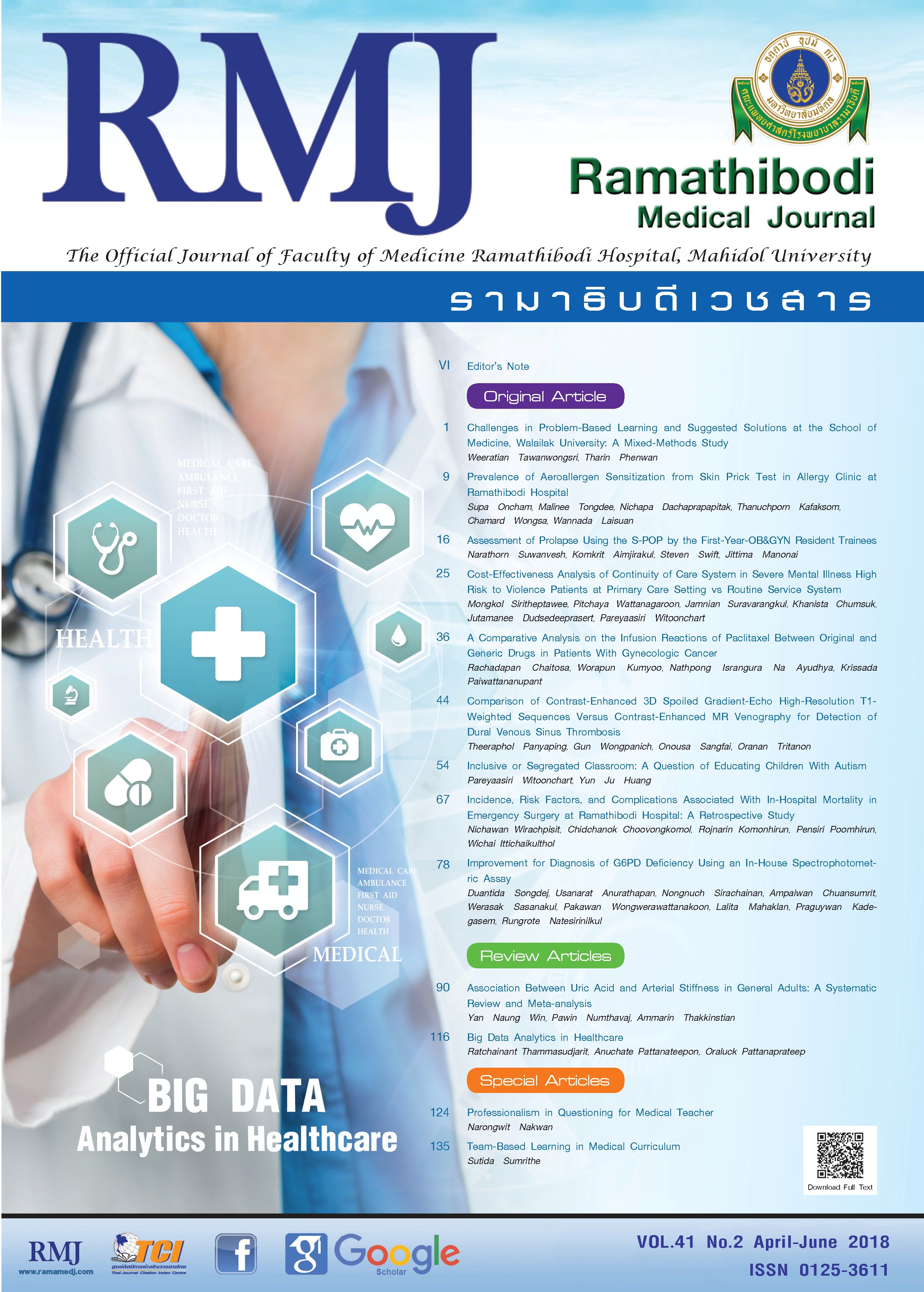Improvement for Diagnosis of G6PD Deficiency Using an In-House Spectrophotometric Assay
DOI:
https://doi.org/10.14456/rmj.2018.18Keywords:
G6PD enzyme assay, G6PD assay cut-offs, G6PD deficiencyAbstract
Background: Glucose-6-phosphate dehydrogenase (G6PD) deficiency is the most common red cell enzyme defect found in Thai population. Accurate diagnosis is essential for counseling.
Objective: To establish a G6PD enzyme assay and reference values.
Methods: G6PD deficient Thai individuals and healthy volunteers were recruited. Identification of G6PD mutations and G6PD enzyme assay were performed in all subjects. The cut-offs for classification of residual enzyme level were identified using Receiver Operating Characteristics (ROC) curves.
Results: Eighty-eight subjects were divided into three groups according to their G6PD genotype: Group 1, Wild-type (n = 35); Group 2, Carrier (n = 27) and Group 3, Deficiency (n = 26). Median G6PD level (interquartile range) of Group 3 was significantly lower than that of Group 2 and Group 1, 0.6 (0.3 to 1.5) vs 5.3 (4.6 to 6.7) vs 9.3 (8.0 to 10.3) IU/gHb; P < 0.01). G6PD level of < 2.9, > 2.9 - 6.7, and > 6.7 IU/gHb were found to be optimum for classification of residual G6PD enzyme into deficiency, intermediate and normal. These cut-offs resulted in 87% sensitivity and 97% specificity for correct classification of enzyme level according to genetic diagnosis. The enzyme level of 78% of subjects in Group 2 were precisely classified as intermediate deficiency. G6PD Viangchan (871G > A) and Canton (1376G > T) are the two most prevalent mutations found.
Conclusions: The established G6PD enzyme assay and its cut-off values provided high sensitivity and specificity for classification of individuals into G6PD deficiency, intermediate and normal.
References
Sodeinde O. Glucose-6-phosphate dehydrogenase deficiency. Baillieres Clin Haematol. 1992;5(2):367-382.
WHO Working Group. Glucose-6-phosphate dehydrogenase deficiency. Bull World Health Organ. 1989;67(6):601-611.
Cappellini MD, Fiorelli G. Glucose-6-phosphate dehydrogenase deficiency. Lancet. 2008;371(9606):64-74. doi:10.1016/S0140-6736(08)60073-2.
Nuchprayoon I, Sanpavat S, Nuchprayoon S. Glucose-6-phosphate dehydrogenase (G6PD) mutations in Thailand: G6PD Viangchan (871G>A) is the most common deficiency variant in the Thai population. Hum Mutat. 2002;19(2):185. doi:10.1002/humu.9010.
Laosombat V, Sattayasevana B, Janejindamai W, et al. Molecular heterogeneity of glucose-6-phosphate dehydrogenase (G6PD) variants in the south of Thailand and identification of a novel variant (G6PD Songklanagarind). Blood Cells Mol Dis. 2005;34(2):191-196. doi:10.1016/j.bcmd.2004.11.001.
Phompradit P, Kuesap J, Chaijaroenkul W, et al. Prevalence and distribution of glucose-6-phosphate dehydrogenase (G6PD) variants in Thai and Burmese populations in malaria endemic areas of Thailand. Malar J. 2011;10:368. doi:10.1186/1475-2875-10-368.
Nantakomol D, Paul R, Palasuwan A, Day NP, White NJ, Imwong M. Evaluation of the phenotypic test and genetic analysis in the detection of glucose-6-phosphate dehydrogenase deficiency. Malar J. 2013;12:289. doi:10.1186/1475-2875-12-289.
Kaplan M, Hammerman C, Vreman HJ, Stevenson DK, Beutler E. Acute hemolysis and severe neonatal hyperbilirubinemia in glucose-6-phosphate dehydrogenase-deficient heterozygotes. J Pediatr. 2001;139(1):137-140. doi:10.1067/mpd.2001.115312.
Matthay KK, Mentzer WC. Erythrocyte enzymopathies in the newborn. Clin Haematol. 1981;10(1):31-55.
Ruwende C, Hill A. Glucose-6-phosphate dehydrogenase deficiency and malaria. J Mol Med (Berl). 1998;76(8):581-588.
Mbanefo EC, Ahmed AM, Titouna A, et al. Association of glucose-6-phosphate dehydrogenase deficiency and malaria: a systematic review and meta-analysis. Sci Rep. 2017;7:45963. doi:10.1038/srep45963.
Baird JK. Point-of-care G6PD diagnostics for Plasmodium vivax malaria is a clinical and public health urgency. BMC Med. 2015;13:296. doi:10.1186/s12916-015-0531-0.
Tagarelli A, Piro A, Bastone L, Condino F, Tagarelli G. Reliability of quantitative and qualitative tests to identify heterozygotes carrying severe or mild G6PD deficiency. Clin Biochem. 2006;39(2):183-186. doi:10.1016/j.clinbiochem.2005.10.015.
Wolf BH, Weening RS, Schutgens RB, van Noorden CJ, Vogels IM, Nagelkerke NJ. Detection of glucose-6-phosphate dehydrogenase deficiency in erythrocytes: a spectrophotometric assay and a fluorescent spot test compared with a cytochemical method. Clin Chim Acta. 1987;168(2):129-136. doi:10.1016/0009-8981(87)90281-6.
Betke K, Beutler E, Brewer GJ, et al. Standardization of procedures for the study of glucose-6-phosphate dehydrogenase. Report of a WHO scientific group. World Health Organ Tech Rep Ser. 1967;366:1-53.
Banyatsuppasin W, Jindadamrongwech S, Limrungsikul A, Butthep P. Prevalence of thalassemia and glucose-6-phosphate dehydrogenase deficiency in newborns and adults at the Ramathibodi Hospital, Bangkok, Thailand. Hemoglobin. 2017;41(4-6):260-266. doi:10.1080/03630269.2017.1402026.
Tanphaichitr VS, Pung-amritt P, Yodthong S, Soongswang J, Mahasandana C, Suvatte V. Glucose-6-phosphate dehydrogenase deficiency in the newborn: its prevalence and relation to neonatal jaundice. Southeast Asian J Trop Med Public Health. 1995;26 Suppl 1:137-141.
Brown WR, Boon WH. Hyperbilirubinemia and kernicterus in glucose-6-phosphate dehydrogenase-deficient infants in Singapore. Pediatrics. 1968;41(6):1055-1062.
Beutler E. A series of new screening procedures for pyruvate kinase deficiency, glucose-6-phosphate dehydrogenase deficiency, and glutathione reductase deficiency. Blood. 1966;28(4):553-562.
Tachavanich K, Viprakasit V, Pung-amritt P, Veerakul G, Chansing K, Tanphaichitr VS. Development of a comprehensive red blood cell enzymopathy laboratory in Thailand: the study of normal activity in eight erythroenzymes in Thais. Southeast Asian J Trop Med Public Health. 2009;40(2):317-326.
Keihanian F, Basirjafari S, Darbandi B, et al. Comparison of quantitative and qualitative tests for glucose-6-phosphate dehydrogenase deficiency in the neonatal period. Int J Lab Hematol. 2017;39(3):251-260. doi:10.1111/ijlh.12618.
LaRue N, Kahn M, Murray M, et al. Comparison of quantitative and qualitative tests for glucose-6-phosphate dehydrogenase deficiency. Am J Trop Med Hyg. 2014;91(4):854-861. doi:10.4269/ajtmh.140194.
Laouini N, Sahli CA, Jouini L, et al. Determination of glucose-6-phosphate dehydrogenase cut-off values in a Tunisian population. Clin Chem Lab Med. 2017;55(8):1193-1201. doi:10.1515/cclm-2016-0253.
Huang CS, Hung KL, Huang MJ, Li YC, Liu TH, Tang TK. Neonatal jaundice and molecular mutations in glucose-6-phosphate dehydrogenase deficient newborn infants. Am J Hematol. 1996;51(1):19-25. doi:10.1002/(SICI)1096-8652(199601)51:1<19::AID-AJH4>3.0.CO;2-A.
Gómez-Manzo S, Marcial-Quino J, Vanoye-Carlo A, et al. Glucose-6-phosphate dehydrogenase: update and analysis of new mutations around the World. Int J Mol Sci. 2016;17(12). pii: E2069. doi:10.3390/ijms17122069.

















